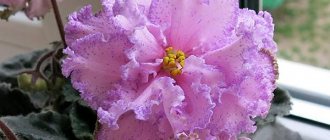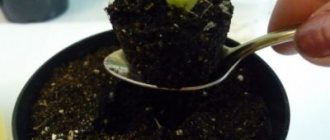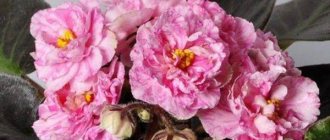Violets are indoor plants that have become very popular for quite some time. And flower growers are indeed constantly purchasing Saintpaulias, striving to expand the varietal line and make the plantings brighter and more colorful. Violets are ideal for decorating window sills and balconies, terraces and loggias, any premises (living rooms, bedrooms, office spaces, studies). If the room or room where the violet grows is bright enough, then containers with Saintpaulia can be placed in the summer on interior items, furniture, and also the containers can be installed very deep in the apartment - enough sunlight will still reach them, and the plants will feel quite attractive. The plant this article is about is the bullfighting violet.
Of course, violets are not just beautiful flowers: they are a variety of varieties and types, shades and colors, flower shapes and foliage parts. This diversity was achieved due to the fact that breeders realized that flowers were becoming very popular, and therefore they constantly sought to expand varietal lines.
As a result, now any florist can find those varieties and forms of violets, their colors that will satisfy the needs of literally every florist, even the most sophisticated. In addition, violets are very easy to care for, because it is enough to follow some requirements and nuances in agricultural technology and care, and this will be enough for the plant itself to demonstrate beautiful colorful flowering in return.
In this article we will talk in more detail about the violet, which has a very unusual name - Bullfight. The violet variety Bullfight is distinguished by the blood-red color of its petals. Perhaps due to the association with bullfighting, Spanish bullfighting, this variety received such an unusual name.
The article and all the information presented in it will be very interesting not only to beginning flower growers, but also to those who already have experience in growing violets, but flower growers are always eager to try something new in order to refresh their plantings and the appearance of the interior, where and containers with violets are placed.
Description of the variety
Violet wedding bouquet - flower description
This violet is easy to distinguish among other similar varieties. Belongs to large-flowered varieties. A distinctive feature of the plant is the presence of a constantly blooming magnificent head of red flowers. The flowers are star-shaped, double or semi-double.
The Bullfight violet blooms all year round. First, 3 peduncles with two buds appear. As soon as they bloom, new 3 buds grow. The result is a spectacular bouquet. If you properly care for the plant and, which is very important, feed it regularly, the flower rosette will reach 30 cm in diameter.
The leaves are large, somewhat elongated, bright green. Their edges are somewhat wavy.
From this variety comes the violet Bullfight gold (that is, “golden”). The leaves of the Violet bullfight gold in the center of the rosette are white or with a lemon tint. The lower leaves are bright and green. Cherry flowers together with these leaves look very beautiful and elegant.
EK Bullfight is similar to the varieties of violets Corrida, Blackberry EK-Magaraj. The bullfighting violet, unlike the bullfighting violet, has large semi-double white flowers.
Violet, description and photo EK-Black Pearl (E. Korshunova)
Violets from breeders of the CIS countries - “Ch”.
EK-Black Pearl (E. Korshunova).
EK-Black Pearl, EK-Chernaia Zhemchuzhina (E. Korshunova).
Large, densely double purple-violet spherical flowers. The sport EK-Grey Ocean (E. Korshunova) is registered from her. The Black Pearl may eventually smoothly transition into the EK-Grey Ocean. Gray Ocean has a light rosette.
Dark green large smooth leaves. Standard. The rosette is large, but even. It likes to lift the leaves upward, the petioles of the rosettes are often long and the rosette becomes disheveled. The trunk quickly becomes exposed. Over time, the rosette deteriorated sharply and turned into a krakozyabra.
Very beautiful double deep purple velvet flowers. The flower takes a long time to open, it is so heavy and terry. The flower size is up to 6-7 cm, blooms small, and then grows and becomes densely double. With each new flowering, the size of the flowers becomes smaller and smaller. By the fourth flowering it produced very small flowers.
Abundant and compact flowering. When flowering, ball flowers form a dense bouquet in the center and do not fade for a long time. It blooms only with a cap. It does not bloom as often as we would like. Powerful peduncles, flowers do not lie around, but over time the peduncles cease to be erect.
It grows slowly, does not bloom for a long time, and grows a rosette of leaves. He prefers the window, the flowers on the window are darker and the rosette is neater. Loves the wick very much, grows quickly. After re-rooting, the flowers were very crushed; there was no cap flowering.
Gives sports with a medium-sized outlet. From children with light leaves you will get sport. Children with dark petioles will produce EK-Black Pearl.
Pearls are hard, round formations extracted from the shells of certain mollusks. Pearls are usually white in color, sometimes cream or pink; There are also yellow, green, black and even blue pearls.
Do you know that…?
Each violet age has its own tasks. And our requirements for each age must be adequate. The baby’s task is to form an active growth point and grow thick, healthy roots. The starter’s task is to show the correct varietal qualities in the first flowering and create a “platform” for the subsequent construction of the rosette form. At the same time, the violet itself knows what kind of “platform” it needs: large or small - this is genetically predetermined for each variety. It is obviously better if this platform is free and spacious (like loose) rather than dense and constrained. Stubbornness in many varieties is an age-related property; a young violet looks loose because it simply doesn’t have enough leaves yet. With age, this goes away on its own (of course, under favorable conditions and well-functioning agricultural technology).
Before you buy the violets listed below, carefully read the forums about their behavior on the windowsill. Many of them are very beautiful flowers. However, these can be large rosettes with large and fragile leaves, with leaves rising up or hugging the pot, forming many stepsons that interfere with the formation of a neat rosette, pulling the stem up and growing into a Christmas tree, bending the trunk, rare flowering with long breaks, fallen flowers or they last little and quickly wither, very long and recumbent peduncles, the color of the flower fades quickly, they do not like bright lighting on the windowsill, they are afraid of the slightest drying out or waterlogging, a large percentage of them go into sports or darken the flower.
Are they suitable for your window sill and the conditions that you can create for them? You will look at the flowers for several months, and the rosette will always be in front of your eyes. There are many beautiful flowers, there are much fewer beautiful and neat rosettes, look first at the rosette! Search and you may find a dozen violets with the same flower color if you are not interested in the smallest details as a collector.
• — Sorcerer (Makuni); • — Blueberry (Repkina); • — Four Seasons (Berdnikova); • — Chubchik Curly (Lebetskaya); • — Wonderful Moment (Repkina); • — Miracle Apples (Height);
Features of care
Description of the flower variety violet Duchess Lux
In order for the plant to please the eye with beautiful flowers and not get sick, you need to strictly and carefully follow the care recommendations.
Temperature
The flower feels excellent at an ambient temperature of 18 to 25 degrees. Violet is afraid of cold and drafts. Higher temperatures also have a detrimental effect on it.
Lighting
It is recommended to grow violets on a flower rack using artificial lighting. It should be placed on windows facing north, northeast or northwest.
Violet loves bright light
Important! Direct rays of the sun have a detrimental effect on violets. Despite this, you need to keep 12 to 14 hours of daylight. The lack of light is compensated by a lamp with a yellow spectrum (not incandescent). Moreover, once every 3 days the plant turns the opposite side to the light source.
Watering
The plant needs sufficient moisture to grow and bloom. Water the plant when the soil in the pot is about a third dry. The violet should be watered with settled water at room temperature. The stream is directed to the root. You should not allow water to get on the leaves - they not only change color, but also begin to rot.
There are several methods of watering:
- Water is poured into the pot using a watering can with a long spout.
- The pot is placed in 2/3 water for about half an hour, so that the moisture is absorbed into the soil through the drainage.
- A wick is pulled through the drainage hole. Its end is placed in a container of water under the pot.
Spraying
The plant cannot be sprayed. Spraying water is allowed at a distance of about 2 meters from the plant.
Humidity
The air humidity in the room where the “Bullfight” violet is located should be no less than 50% and no more than 65%. Air humidity can be increased by placing containers filled with water near the plant.
Priming
You need to use a purchased soil mixture for violets. You can prepare it yourself by mixing peat, leaf, turf and coniferous soil, and sand in equal proportions. A small amount of perlite or vermiculite is used to loosen the soil.
Soil for violets
Feeding
Fertilizers are applied every 2 weeks. Nitrogen fertilizers are necessary during the formation of the rosette and the active growth of leaves.
When buds form, or when a plant blooms, it needs phosphorus and potassium, as well as trace elements. Fertilizing is carried out with mineral mixtures. The recommended concentration of fertilizer should be reduced by approximately 2 times.
Note! Fertilizing is carried out only for healthy plants. After transplantation, fertilizers are not applied for 2 months. The same restriction applies if the violet has been affected by disease.
During the flowering period
During the flowering period, violets need regular watering. The gardener's task is to maintain a normal level of soil moisture. It should not be dry and at the same time overly flooded with water.
In addition, the plant regularly needs phosphorus fertilizers so that the flowers are powerful and rich in color. The plant is fed strictly according to the instructions for using the fertilizer.
When and how does it bloom
Violet Black Pearl - description of a home flower
The plant is distinguished by some peculiarities in flowering.
Color and design of flowers
Interesting. The shade of the petals changes depending on the lighting: in the sun they are scarlet, in cloudy weather they are ruby or cherry.
Violets of this variety have practically no colors that would differ significantly from the red color scheme.
Saintpaulia flower
Flower shape and size
The size of the flowers is large - up to 8 cm. The flowers are star-shaped, double.
Flowering period
A distinctive feature of this variety of violet is that it blooms throughout the year. The rosette constantly throws out new flower stalks, on which beautiful and lush flowers grow.
Flowering period
With good care, violets bloom almost all year round: up to 8-9 months. The flowering of Saintpaulia is not related to the time of year, but mainly depends on the growing conditions created for it. The most abundant flowering is observed in spring and summer. It is difficult to predict exactly when a plant will bloom. Violets grown from leaves can bloom in 8 months, some take a whole year, sometimes you have to wait a year and a half. There are varieties (Sorano selection) that bloom all year round:
- Emerald Pink with many flowers in shades of light coral pink, surrounded by a border of light green.
- Anastasia, distinguished by light flowers with sky-blue watercolor petals, marked with dark stains, with corrugated edges.
How to propagate violets
There are several ways to propagate violets: by seeds, leaves, or daughter rosettes.
Germination of seeds
Growing this violet using seeds has many complex steps and is therefore only accessible to breeders.
Rooting cuttings
The leaf must be cut from the second row of the rosette. The cut is made with a sharp knife along an oblique line approximately 3 cm from the base of the leaf plate. The cutting is placed in a small container with water or a mixture of soil and sand. After the roots appear, the cuttings need to be planted in a pot with soil. The babies will appear in about a month.
To obtain daughter rosettes, they need to be cut and rooted. Small daughter rosettes appear on the stump remaining after cutting the plant. When they have increased by about 3 cm, they are separated from the outlet and then transplanted into small pots. They need to be covered with a bag on top. The cover is removed when new leaves appear on the rosette. When they grow to about 4 cm, they are removed.
Rooting and germination of cuttings
Other options
There is a way to propagate violets using leaves. The sequence of actions will be as follows:
- cut a leaf;
- place it about 2 cm into the soil, lightly squeeze the soil around it;
- cover with a glass jar and pour over.
Reproduction methods
Vegetative methods are used to propagate violets:
The seed method is quite lengthy and labor-intensive; it is usually used for selection by professional flower growers. At home, cuttings are used to obtain new specimens. Using a sharp knife, cut off a leaf capable of forming adventitious roots, moving 2.5-3.5 cm away from the leaf plate. The cuttings are placed in a container with water and transferred to a warm, bright place. Cover with a plastic cup or plastic bag to create greenhouse conditions. Usually, after 2-3 weeks, the first roots appear and the cuttings are transplanted into the ground. When the shoots reach 4-5 cm in height, the violet has taken root and began to grow, the parent leaf is cut off. To propagate variegated forms, take cuttings from the 2nd row, young and strong, they take root more easily. In this case, choose the greenest leaves of the rosette.
Important! If the leaves of the emerging rosette are white, you should wait until they turn green and only then separate them from the cuttings. There are varieties that cannot be propagated by cuttings from leaves, because
they do not retain parental characteristics. In this case, cuttings of peduncles are used, choosing the strongest and healthiest. Next, proceed as with ordinary cuttings, waiting for the roots to appear. In some varieties, lateral shoots are formed - stepsons; they are removed and rooted like ordinary cuttings
There are varieties that cannot be propagated by cuttings from leaves, because... they do not retain parental characteristics. In this case, cuttings of peduncles are used, choosing the strongest and healthiest. Next, proceed as with ordinary cuttings, waiting for the roots to appear. In some varieties, lateral shoots are formed - stepsons; they are removed and rooted like ordinary cuttings.
Replanting after purchase
The violet is replanted every year, around the beginning of March. This frequency is due to the fact that prolonged flowering leads to soil depletion. The plant needs fresh substrate with nutrients. The pot should be wide and low, because the root of the plant occupies the surface layer of soil. Its other layers will acidify. The diameter of the pot should be no more than 12 cm.
Important! Violets will not bloom in bulky containers.
Drainage in the form of small pebbles, gravel, and foam is placed at the bottom of the pot. It will remove excess moisture and prevent rotting.
Growing conditions
In order for a flower to develop well, it is necessary to take into account its wishes regarding its cultivation, that is, fulfill some requirements for caring for it:
- The container for violets is not high, but wide, with a volume of no more than a liter.
- Replanting is done annually in the spring with inspection of the plant’s root system and replacement of the soil.
- Where the violet lives there should be no cold drafts.
- The temperature regime for normal violet growth should be within 18-25 degrees Celsius.
Possible problems
Violet diseases develop if it suffers from a lack of sunlight or, conversely, is exposed to strong insolation, watered with cold water, or located in a room with low temperature and high humidity. As soon as the first signs of damage appear, you should remove all diseased leaves and transplant the plant into a new pot with new soil. The leaves are treated with an appropriate preparation with a fungicidal effect.
Diseases
The most common diseases of the Bullfight violet are late blight, gray or powdery mildew, fusarium, and gray rot. All of them develop due to excessive watering or non-compliance with maintenance conditions.
It is possible to save a violet only at the early stages of the development of the disease. The affected parts of the plant are thrown away, healthy leaves are treated with drugs.
Powdery mildew
Pests
The following pests pose the greatest danger to the plant:
- aphid;
- thrips;
- mites;
- nematodes;
- fungus mosquitoes;
- Scale insects.
If the leaves of the plant are affected by these pests, you need to wash them with a soapy solution, then treat them with the insecticidal solution of Alatar, Actellik, Furanon, etc.
Other problems
The variety is somewhat capricious. Sometimes flowering is unstable, double petals appear after the third flowering.
It happens that the leaves of the bottom row begin to turn yellow prematurely. This phenomenon is independent of ambient temperature. Yellowing of the leaves does not mean that the plant is affected by any disease. The lower leaves may constantly turn yellow and fall off, and new ones grow in their place.
The “Bullfight” violet is an excellent decoration for any room. The undoubted advantage of the plant is its ability to bloom all year round. The plant requires care, for which it gives beautiful flowers in gratitude.











